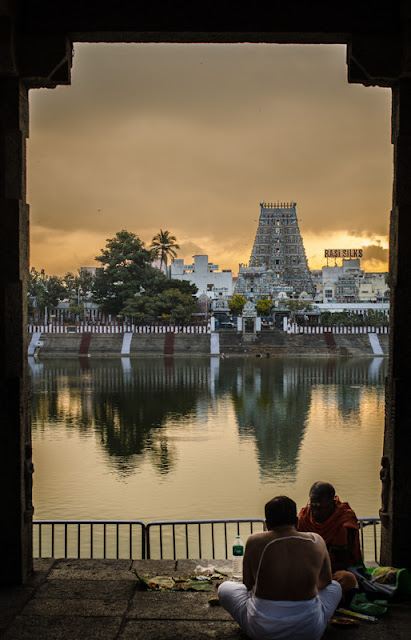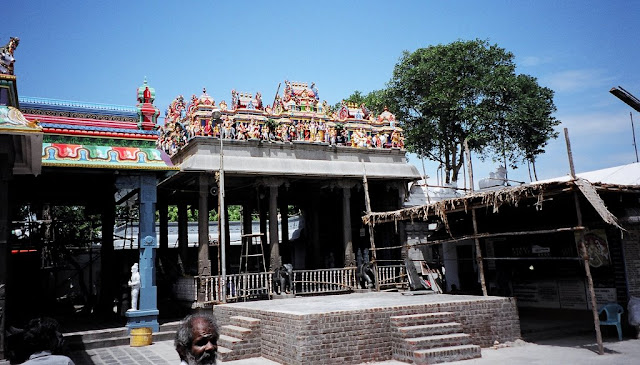Kapaleeshwarar Temple, Mylapore, Chennai
Kapaleeshwarar
Temple is a Hindu temple dedicated to Lord Shiva located in Mylapore in Chennai in the Indian state of Tamilnadu. The temple has a majestic 7-tiered Gopuram of 37
meters in height with intricate patterns of sculpted figures in cool
eye-pleasing colors is a treat to watch. The temple complex houses many halls
and has a big tank in the west. There is one more courtyard that houses the
shrines of 63 saints. There are inscriptions on the temple structure which
dates to the 7th century. The temple faces towards East and the
entrance is marked in Puranic inscriptions. The view of the temple from the
outside is magnificent and awesome.
According
to the Puranas, Shakti worshipped Shiva in the form of a peacock, giving the vernacular name Mylai (Mayilai) to the area that developed around the temple - mayil is Tamil for "peacock". Shiva
is worshiped as Kapaleeshwarar, and is represented by the lingam. His
consort Parvati is depicted as Karpagambal. The temple was built
on the seashore around the 7th century CE in Dravidian architecture; but was destroyed by the Portuguese when Mylapore fell
into their hands in 1566 AD. The present masonry structure was built during the
Vijayanagar rulers of the Tuluva
Dynasty (1491–1570 CE).
This
famous temple finds mention in the 7th century Tamil Shaiva
canonical work, the Thevaram, written by Tamil saint poets known as the Nayanmars
and classified as Paadal Petra Sthalam. The temple and the deity were
immortalized in the works of Thevaram by poet-saint belonging to the 7th
century; Thirugnana Sambandhar has composed the 6th Poompavai
Pathigam in praise of the temple.
This is one of the 276 Devara Paadal Petra Shiva Sthalams and 24th Shiva Sthalam in Thondai Nadu. Arunagirinathar, the 15th century poet sang praises of the temple in Thirumayilai Thirupugazh. The 12th century poet Guna Veera Pandithar sings about Neminathar under Theerthangar Neminathar Pugazh. Thirumayilai Prabanthangal is a compilation of four works on the temple and the deity.
This
temple is also one of the Saptha Sthana Shiva Sthalams in Mylapore,
Chennai, like Thiruvaiyaru. The other six temples are Kaaraneecharam (Middle of
Bazar Street), Theerthapaleeswarar temple (Middle of Dr Natesan Road),
Velleecharam (South Mada street - Near Kapaleeshwarar Temple), Virupaksheewarar
Temple (Bazar Road near Kaaraneeswarar temple), Vaaleeswarar Temple (In the
opposite street of Kaaraneeswarar temple) and Malleeswarar Temple (Back side of
Kaaraneeswarar temple - Next lane).
The
temple has six daily rituals at various times from 5:30 a.m. to 10 p.m.,
and four yearly festivals on its calendar. The place witnesses a huge crowd
during the Arupathu Moovar Vizha Festival. There are processions, sweet
distribution ceremonies and classical dance performance in the nearby region.
The ten days festival gives the temple and the area of Mylapore a new tint of
excitement. The temple is maintained and administered by the Hindu Religious and
Endowment Board of the Government of Tamilnadu.
Legends
For
brief details, please refer below link;
History
For
brief details, please refer below link;
The
Temple
For
brief details, please refer below link;
Temple
Opening Time
The
temple is open from 5.00 a.m. to 12.30 p.m. and from 4.00 p.m. to 9.30 p.m.
Pooja
Timings
For
brief details, please refer below link;
Festivals
For
brief details, please refer below link;
Religious
Practices
For
brief details, please refer below link;
Literary
Mention
For
brief details, please refer below link;
Prayers
Devotees
pray to Lord for mental peace and Mother Karpakambika for child, wedding and
family welfare. It is the staunch belief of devotees that their
prayer brings them relief from any illness. Those suffering from any disease,
carry sugar in a pot and distribute to devotees on the 8th day of
Thaipoosam festival. They perform abishek and Aaradhanas to Lord Mother
offering vastras.
Contact
Kapaleeshwarar
Temple,
Mylapore,
Vadakku Maada Veethi
Chennai
– 600 004
Phone: +91 44 2464 1670 / 2461 1356
Connectivity
For brief
details, please refer below link;






























